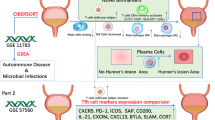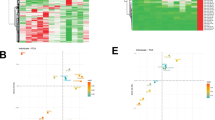Abstract
Introduction and hypothesis
The aim of this study was to explore potential molecular mechanisms contributing to the pathogenesis of Hunner’s ulcer type interstitial cystitis (IC).
Methods
Dataset acquisitions from Gene Expression Omnibus under platform accession no GSE 11783. We compared global gene expression profiles in bladder epithelial cells from IC patients with Hunner’s ulcer corresponding to normal controls. We re-sampling and exploit the correlation structure presented in the dataset through the transcriptional response. For each patient, two bladder biopsies were studied, one from an ulcer area and one from a non-ulcer area. RNA was extracted, and all labeled samples were hybridized to Human Genome U133 Plus 2.0 Array (Affymetrix, CA, USA).
Results
The Mahalanobis distance in hierarchical cluster analysis revealed a model of 40 genes expression which is increased in IC and ulcerated IC. Our results can be summarized as follows: First, the expressions of major histocompatibility complex (MHC) class IF and II molecules, leukocyte immunoglobulin-like receptors, hepatitis A virus cellular receptor 2, and interleukin 32 were increased in bladder epithelial from IC and ulcerative IC area. Next, there is an indication of antigen-mediated aggregation of the high-affinity Fc epsilon and gamma RI leading to allergic inflammation through the disease status. Third, the high-affinity Fc gamma RI subunit facilitated T-cell-mediated immune response through the disease status. Such changes, jointly termed “bladder remodeling,” can constitute an important long-term consequence of Hunner’s ulcer type IC.
Conclusions
Our results indicate that genome-based expression profiling can be used for the diagnostic tests of Hunner’s ulcer type IC in clinical practice.



Similar content being viewed by others
References
Rover E, Esdridge M (2005) Interstitial cystitis, eMedicine from Web MD
Tseng LH, Chen I, Chen MY et al (2009) Genome-based expression profiling as a single standardized microarray platform for the diagnosis of experimental interstitial cystitis: an array of 75 genes model. Int J Urogynecol 20:509–513
Tseng LH, Chen I, Chen MY et al (2009) Genome-based expression profiling as a single standardized microarray platform for the diagnosis of bladder pain syndrome/interstitial cystitis: an array of 139 genes model. Int J Urogynecol 20:515–522
Parsons CL, Greenberger M, Gabal L et al (1998) The role of urinary potassium in the pathogenesis and diagnosis of interstitial cystitis. J Urol 159:1862–1867
Parsons CL (2007) The role of the urinary epithelium in the pathogenesis of interstitial cystitis/prostatitis/urethritis. Urology 69:9–16. Review
Gamper M, Viereck V, Geissbühler V et al (2009) Gene expression profile of bladder tissue of patients with ulcerative interstitial cystitis. BMC Genomics 10:199
Hruz T, Laule O, Szabo G et al (2008) Genevestigator V3: a reference expression database for the meta-analysis of transcriptomes. Adv Bioinformatics 2008:420747
Maglott D, Ostell J, Pruitt KD et al (2007) Entrez Gene: gene-centered information at NCBI. Nucleic Acids Res 35:D26–D31
Tseng LH, Chen I, Chen MY et al (2010) Genome-based expression profiling as a single standardized microarray platform for the diagnosis of endometrial disorder: an array of 126-gene model, Fertil Steril (in press)
Tseng LH, Chen I, Lin YH et al (2009) Genome-based expression profiling study following spinal cord injury in the rat: an array of 48-gene model, Neurourol Urodyn (in press)
Mimmack GM, Mason SJ, Galpin JS (2001) Choice of distance matrices in cluster analysis of defining regions. J Climate 14:2790–2797
Eisen MC, Spellman PT, Patrick PO et al (1998) Proc Natl Acad Sci 95:14863–14868
The Gene Ontology Consortium (2008) The Gene Ontology project in 2008. Nucleic Acids Res 36:D440–D444
Carbon S, Ireland A, Mungall CJ et al (2008) AmiGO Hub; Web Presence Working Group. “AmiGO: online access to ontology and annotation data.”. Bioinformatics 25:288–289
Trombetta ES, Mellman I (2005) Cell biology of antigen processing in vitro and in vivo. Annu Rev Immunol 23:975–1028
Paolini R, Renard V, Vivier E et al (1995) Different roles for the Fc episilon RI gamma chain as a function o the receptor context. J Exp Med 181:247–255
Peccoud J, Dellabona P, Allen P et al (1990) Delineation of antigen contact residues on an MHC class II molecule. EMBO J 9:4215–4223
Potashov LV, Savranskiĭ VM, Berkos AS et al (1994) The association of HLA antigens with gastric and duodenal peptic ulcer. Vestn Khir Im I I Grek 152:14–17, Russian
Verhagen C, Den Heijer R, Klooster J et al (1991) Elimination of immune precipitates from the rat corneal stroma: a histological study. Exp Eye Res 31:471–478
Yuceyar H, Saruc M, Kokuludag A et al (2002) The systemic cellular immune response in the Helicobacter pylori-associated duodenal ulcer and chronic antral gastritic. Hepatogastroenterology 49:1177–1179
Humphreys TL, Li L et al (2007) Dysregulated immune profiles for skin and dendritic cells are associated with increased host susceptibility to Haemophilus ducreyi infection in human volunteers. Infect Immun 5:5686–5697
Sayed BA, Christy A, Quirion MR et al (2008) The master switch: the role of mast cells in autoimmunity and tolerance. Annu Rev Immunol 26:705–739
Dahl CA, Schall RP, He HL et al (1992) Identification of a novel gene expressed in activated natural killer cells and T cells. J Immunol 148:57–603
Joosten LA, Netea MG, Kim SH et al (2006) IL32, a proinflammatory cytokine in rheumatoid arthritis. Proc Natl Acad Sci USA 103:3298–3303
Shioya M, Nishida A, Yagi Y et al (2007) Epithelial overexpressions of interleukin-32apha in inflammatory bowel disease. Clin Exp Immunol 149:480–486
Kaplan CD, O'Neill SK, Koreny T et al (2002) Development of inflammation in proteoglycan-induced arthritis is dependent on Fc gamma R regulation of the cytokine/chemokine environment. J Immunol 169:5851–5859
Le Coniat M, Kinet JP, Berger R (1990) The human genes for the alph and gamma subunits of the mast cell receptor for immunoglobulin E are located on human chromosome band 1q23. Immunogenetics 32:183–136
Jackman JK, Motto DG, Sun O et al (1995) Molecular clonding of SLP-76, a 76-kD tyrosine phophoprotein associated with Grb2 in T cells. J Biol Chem 270:7029–7032
Kolset SO, Zernichow L (2008) Serglycin and secretion in human monocytes. Glycoconu J 25:305–311
Slavik JM, Hutchcrot JE, Bierer BE (1999) CD80 and CD86 are not equivalent in their ability to induce the tyrosince phosphorylation of CD28. J Biol Chem 274:3116–3124
Föger N, Rangell L, Danilenko DM et al (2006) Requirement for coronin 1 in T lymphocyte trafficking and cellular homeostsis. Science 313:839–842
Authors’ contribution
L.H. Tseng wrote the paper; I. Chen developed analytical tools, analyzed data, and wrote the paper; C.N. Wang and Y.H. Lin validated the results; C.Y. Lee and L.K. Lloyd supervised the project.
Conflicts of interest
None.
Author information
Authors and Affiliations
Corresponding author
Additional information
Ling-Hong Tseng and Ilene Chen contributed equally to this paper.
Rights and permissions
About this article
Cite this article
Tseng, LH., Chen, I., Wang, CN. et al. Genome-based expression profiling study of Hunner’s ulcer type interstitial cystitis: an array of 40-gene model. Int Urogynecol J 21, 911–918 (2010). https://doi.org/10.1007/s00192-010-1129-x
Received:
Accepted:
Published:
Issue Date:
DOI: https://doi.org/10.1007/s00192-010-1129-x




